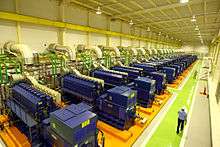Energy in Brazil
Brazil is the largest energy consumer in South America. It is the most important oil and gas producer in the region and the world's largest ethanol fuel producer. The government agencies responsible for energy policy are the Ministry of Mines and Energy (MME), the National Council for Energy Policy (CNPE), the National Agency of Petroleum, Natural Gas and Biofuels (ANP) and the National Agency of Electricity (ANEEL).[1][2][3] State-owned companies Petrobras and Eletrobras are the major players in Brazil's energy sector, as well as Latin America's.
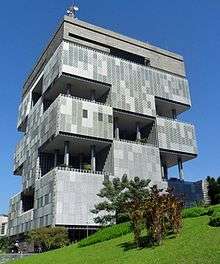
Overview
.png)
| Energy in Brazil[4] | ||||||
|---|---|---|---|---|---|---|
| Capita | Prim. energy | Production | Import | Electricity | CO2-emission | |
| Million | TWh | TWh | TWh | TWh | Mt | |
| 2004 | 183.9 | 2,382 | 2,050 | 364 | 360 | 323 |
| 2007 | 191.6 | 2,740 | 2,507 | 289 | 413 | 347 |
| 2008 | 192.0 | 2,890 | 2,653 | 314 | 429 | 365 |
| 2009 | 193.7 | 2,793 | 2,679 | 182 | 426 | 338 |
| 2010 | 195.0 | 3,089 | 2,865 | 289 | 465 | 388 |
| 2012 | 196.7 | 3,140 | 2,898 | 333 | 480 | 408 |
| 2012R | 198.7 | 3,276 | 2,930 | 391 | 498 | 440 |
| 2013 | 200.0 | 3,415 | 2,941 | 531 | 517 | 517 |
| Change 2004-10 | 6.0 % | 30 % | 40 % | -21 % | 29 % | 20 % |
| Mtoe = 11.63 TWh, Prim. energy includes energy losses >
2012R = CO2 calculation criteria changed, numbers updated | ||||||
Reforms of the energy sector
At the end of the 1990s and the beginning of the 2000s, Brazil's energy sector underwent market liberalization. In 1997, the Petroleum Investment Law was adopted,[5] establishing a legal and regulatory framework, and liberalizing oil production. It created the CNPE and the ANP, increased use of natural gas, increased competition in the energy market, and increased investment in power generation. The state monopoly on oil and gas exploration ended, and energy subsidies were reduced. However, the government retained monopoly control of key energy complexes and regulated the price of certain energy products.[6]
Current government policies concentrate mainly on improving energy efficiency in both residential and industrial sectors, as well as increasing use of renewable energy. Further restructuring of the energy sector will be one of the key issues for ensuring sufficient energy investments to meet the rising need for fuel and electricity.[6]
Primary energy sources
Oil

Brazil is the world's 12th-largest oil producer. Up to 1997, the government-owned Petróleo Brasileiro S.A. (Petrobras) had a monopoly on oil. More than 50 oil companies now are engaged in oil exploration.[1] The only global oil producer is Petrobras, with an output of more than 2 million barrels (320,000 m3) of oil equivalent per day. It is also a major distributor of oil products, and owns oil refineries and oil tankers.[7]
In 2006, Brazil had 11.2 billion barrels (1.78×109 m3) the second-largest proven oil reserves in South America after Venezuela. The vast majority of proven reserves were located in the Campos and Santos offshore basins off the southeast coast of Brazil.[7] In November 2007, Petrobras announced that it believed the offshore Tupi oil field had between 5 and 8 billion barrels (1.3×109 m3) of recoverable light oil and neighbouring fields may even contain more, which all in all could result in Brazil becoming one of the largest producers of oil in the world.[8]
Brazil has been a net exporter of oil since 2011.[9] However, the country still imports some light oil from the Middle East, because several refineries, built in the 1960s and 1970s under the military government, are not suited to process the heavy oil in Brazilian reserves, discovered decades later.
Transpetro, a wholly owned subsidiary of Petrobras, operates a crude oil transport network. The system consists of 6,000 kilometres (3,700 mi) of crude oil pipelines, coastal import terminals, and inland storage facilities.[7]
Natural gas
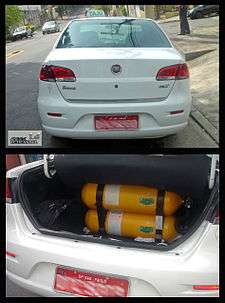
At the end of 2017, the proven reserves of Brazil's natural gas were 369 x 109 m³, with possible reserves expected to be 2 times higher [10]. Until recently natural gas was produced as a by-product of the oil industry. The main reserves in use are located at Campos and Santos Basins. Other natural gas basins include Foz do Amazonas, Ceara e Potiguar, Pernambuco e Paraíba, Sergipe/Alagoas, Espírito Santo and Amazonas (onshore).[2] Petrobras controls over 90 percent of Brazil’s natural gas reserves.[7]
Brazil's inland gas pipeline systems are operated by Petrobras subsidiary Transpetro. In 2005, construction began on the Gas Unificação (Gasun pipeline) which will link Mato Grosso do Sul in southwest Brazil, to Maranhão in the northeast. China’s Sinopec is a contractor for the Gasene pipeline, which will link the northeast and southeast networks. Petrobras is also constructing the Urucu-Manaus pipeline, which will link the Urucu gas reserves to power plants in the state of Amazonas.[7]
In 2005, the gas production was 18.7 x 109 m³, which is less than the natural gas consumption of Brazil.[1] Gas imports come mainly from Bolivia's Rio Grande basin through the Bolivia-Brazil gas pipeline (Gasbol pipeline), from Argentina through the Transportadora de Gas de Mercosur pipeline (Paraná-Uruguayana pipeline), and from LNG imports. Brazil has held talks with Venezuela and Argentina about building a new pipeline system Gran Gasoducto del Sur linking the three countries; however, the plan has not moved beyond the planning stages.[7]
Coal
Brazil has total coal reserves of about 30 billion tonnes, but the deposits vary by the quality and quantity. The proved recoverable reserves are around 10 billion tonnes.[11] In 2004 Brazil produced 5.4 million tonnes of coal, while coal consumption reached 21.9 million tonnes.[1] Almost all of Brazil’s coal output is steam coal, of which about 85% is fired in power stations. Reserves of sub-bituminous coal are located mostly in the states of Rio Grande do Sul, Santa Catarina and Paraná.[11]
Oil shale
Brazil has the world's second largest known oil shale (the Irati shale and lacustrine deposits) resources and has second largest shale oil production after Estonia. Oil shale resources lie in São Mateus do Sul, Paraná, and in Vale do Paraíba. Brazil has developed the world’s largest surface oil shale pyrolysis retort Petrosix, operated by Petrobras. Production in 1999 was about 200,000 tonnes.[12][13]
Uranium
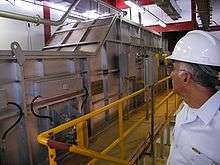
Brazil has the 6th largest uranium reserves in the world.[14] Deposits of uranium are found in eight different states of Brazil. Proven reserves are 162,000 tonnes. Cumulative production at the end of 2002 was less than 1,400 tonnes. The Poços de Caldas production centre in Minas Gerais state was shut down in 1997 and was replaced by a new plant at Lagoa Real in Bahia. There is a plan to build another production center at Itatiaia.[11]
Electricity
Power sector reforms were launched in the mid-1990s and a new regulatory framework was applied in 2004. In 2004, Brazil had 86.5 GW of installed generating capacity and it produced 387 Twh of electricity.[1] As of today 66% of distribution and 28% of power generation is owned by private companies.[1] In 2004, 59 companies operated in power generation and 64 in electricity distribution.[3]
The major power company is Centrais Elétricas Brasileiras (Eletrobrás), which together with its subsidiaries generates and transmits approximately 60% of Brazil's electric supply. The largest private-owned power company is Tractebel Energia.[7] An independent system operator (Operador Nacional do Sistema Elétrico - ((ONS)), responsible for the technical coordination of electricity dispatching and the management of transmission services, and a wholesale market were created in 1998.[3]
During the electricity crisis in 2001 [15], the government launched a program to build 55 gas-fired power stations with a total capacity of 22 GW, but only 19 power stations were built, with a total capacity of 4,012 MW.[6]
Hydropower

Brazil is the third largest hydroelectricity producer in the world after China and Canada.[1] The gross theoretical capability exceeds 3,000 TWh per annum, of which 800 TWh per annum is economically exploitable.[11] In 2004, Brazil produced 321TWh of hydropower.[16] In 2019, Brazil had 217 hydroelectric plants in operation, with an installed capacity of 98,581 MW, 60,16% of the country's energy generation.[17]
In total electricity generation, in 2019 Brazil reached 170,000 megawatts of installed capacity, more than 75% from renewable sources (the majority, hydroelectric plants).[18][19]
In 2013, the Southeast used about 50% of the load of the National Integrated System (SIN), being the main energy consuming region in the country. The region's installed electricity generation capacity totaled almost 42,500 MW, which represented about a third of Brazil's generation capacity. The hydroelectric generation represented 58% of the installed capacity in the region, with the remaining 42% basically corresponding to the thermoelectric generation. São Paulo accounted for 40% of this capacity; Minas Gerais by about 25%; Rio de Janeiro by 13.3%; and Espírito Santo for the rest. [20]
The South Region has the Itaipu Dam, which was the largest hydroelectric plant in the world for several years, until the inauguration of the Three Gorges Dam in China. Remains the world's second largest operational hydroelectric power plant. Brazil co-owns the Itaipu Dam with Paraguay: the dam is on the Paraná River, located on the border between the countries. It has an installed generation capacity of 14 GW by 20 generating units of 700 MW each.[21]
Northern Brazil has large hydroelectric plants such as Belo Monte and Tucuruí, which produce much of the national energy.
Brazil's hydroelectric potential has not yet been fully explored, so the country still has the capacity to build several renewable energy plants in its territory.
Nuclear energy
Nuclear energy accounts for about 4% of Brazil's electricity.[22] The nuclear power generation monopoly is owned by Eletronuclear (Eletrobrás Eletronuclear S/A), a wholly owned subsidiary of Eletrobrás. Nuclear energy is produced by two reactors at Angra. It is located at the Central Nuclear Almirante Álvaro Alberto (CNAAA) on the Praia de Itaorna in Angra dos Reis, Rio de Janeiro. It consists of two pressurized water reactors, Angra I, with capacity of 657 MW, connected to the power grid in 1982, and Angra II, with capacity of 1,350 MW, connected in 2000. A third reactor, Angra III, with a projected output of 1,350 MW, is planned to be finished by 2014 and work has been paralyzed due to environmental concerns, but the licenses are being approved and the heavy construction work will start in 2009. By 2025 Brazil plans to build seven more reactors.[23]
Brazil signed a nuclear cooperation agreement with Argentina since 1991.[24]
Solar power
As of June 2020, according to ONS, total installed capacity of photovoltaic solar was 5.7 GW, with average capacity factor of 22%. Some of the most irradiated Brazilian States are MG ("Minas Gerais"), BA ("Bahia") and GO (Goiás), which have indeed world irradiation level records. [25][26][27] In 2019, solar power represented 1,27% of the energy generated in the country. [28]
Wind energy
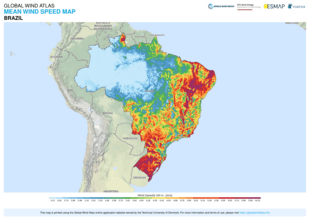
Brazil's gross wind resource potential is estimated to be about 140 GW, of which 30 GW could be effectively transformed into wind power projects.[11] As of June 2020, according to ONS, total installed capacity was 16.6 GW, with average capacity factor of 44%. While the world average wind production capacity factors is 24,7%, there are areas in Northern Brazil, specially in "Bahia" State, where we can find wind farms with average capacity factors over 60%. Indeed Brazil is the country with best average wind capacity factor. [30] [31][26] In 2019, wind energy represented 9% of the energy generated in the country. [32]
Biofuels
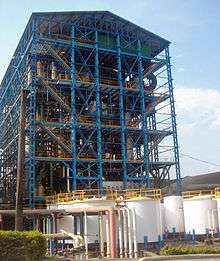
Due to its ethanol fuel production, Brazil has sometimes been described as a bio-energy superpower.[33] Ethanol fuel is produced from sugar cane. Brazil has the largest sugar cane crop in the world, and is the largest exporter of ethanol in the world. With the 1973 oil crisis, the Brazilian government initiated in 1975 the Pró-Álcool program. The Pró-Álcool or Programa Nacional do Álcool (National Alcohol Program) was a nationwide program financed by the government to phase out all automobile fuels derived from fossil fuels in favour of ethanol. The program successfully reduced by 10 million the number of cars running on gasoline in Brazil, thereby reducing the country's dependence on oil imports.
The production and consumption of biodiesel is expected to reach to 2% of diesel fuel in 2008 and 5% in 2013.[1]
Brazil's peat reserves are estimated at 25 billion tonnes, the highest in South America. However, no production of peat for fuel has yet been developed. Brazil produces 65 million tonnes of fuelwood per year. The annual production of charcoal is about 6 million tonnes, used in the steel industry. The cogeneration potential of agricultural and livestock residues varies from 4 GW to 47 GW by 2025.[11]
Critics
The Munduruku indigenous group in Pará state faced problems with the authorities who wanted to build hydropower plants on the Tapajós river without their permission.[34]
Further reading
- Silvestre, B. S., Dalcol, P. R. T. (2009) Geographical proximity and innovation: Evidences from the Campos Basin oil & gas industrial agglomeration — Brazil. Technovation, Vol. 29 (8), pp. 546–561.
References
- OECD/IEA. World Energy Outlook 2006. ISBN 92-64-10989-7
- "Project Closing Report. Natural Gas Centre of Excellence Project. Narrative" (PDF). 20 March 2005. Archived from the original (PDF) on 2007-09-27. Retrieved 2007-05-12.
- "OECD Economic Survey of Brazil 2005: Regulation of the electricity sector" (PDF). Retrieved May 12, 2007.
- IEA Key World Energy Statistics Statistics 2015, 2014 (2012R as in November 2015 + 2012 as in March 2014 is comparable to previous years statistical calculation criteria, 2013, 2012, 2011, 2010, 2009 Archived 2013-10-07 at the Wayback Machine, 2006 Archived 2009-10-12 at the Wayback Machine IEA October, crude oil p.11, coal p. 13 gas p. 15
- "Brazil's Senate approves new petroleum investment law". Oil and Gas Journal. PennWell Petroleum Group. July 28, 1997. Retrieved February 11, 2018.
- "Critical issues in Brazil's energy sector" (PDF). Baker Institute. June 2004. Archived from the original (PDF) on 2007-07-09. Retrieved 2007-05-19.
- Country Analysis Brief. Brazil, US Energy Information Agency, August 2006
- Gary Duffy (2007-11-09). "Brazil announces new oil reserves". BBC. Retrieved 2007-12-12.
- Brasil se tornará exportador líquido de petróleo em 2011, diz AIE
- Thania. "ANP divulga dados de reservas de petróleo e gás em 2017". www.anp.gov.br (in Portuguese). Retrieved 2018-10-28.
- "Survey of energy resources" (PDF). World Energy Council. 2004. Retrieved 2007-07-13. Cite journal requires
|journal=(help) - Review on oil shale data, by Jean Laherrere, September 2005
- Altun, N. E.; Hiçyilmaz, C.; Hwang, J.-Y.; Suat Bağci, A.; Kök, M. V. (2006). "Oil Shales in the world and Turkey; reserves, current situation and future prospects: a review" (PDF). Oil Shale. A Scientific-Technical Journal. 23 (3): 211–227. ISSN 0208-189X. Retrieved 2007-06-16.
- Ronaldo C. Fabrício (March 20, 2005). "Outlook of Nuclear Power in Brazil" (PDF). Eletronuclear. Archived from the original (PDF) on October 6, 2007. Retrieved 2007-05-12.
- "A struggle for power". The Economist. Retrieved 2018-09-24.
- "Key World Energy Statistics -- 2006 Edition" (PDF). International Energy Agency. 2006. Archived from the original (PDF) on 2007-07-09. Retrieved 2007-07-13.
- Quantas usinas geradoras de energia temos no Brasil?
- Brasil alcança 170 mil megawatts de capacidade instalada em 2019
- "IEMA (Instituto de Energia e Meio Ambiente),2016.Série TERMOELETRICIDADE EM FOCO: Uso de água em termoelétricas" (PDF). Archived from the original (PDF) on 2018-04-01.
- O BNDES e a questão energética e logística da Região Sudeste
- "Power: World's biggest hydroelectric facility". USGS. Archived from the original on May 19, 2006. Retrieved May 18, 2006.
- "Nuclear Power in Brazil. Briefing Paper # 95". Uranium Information Centre. May 2007. Archived from the original on 2007-02-08. Retrieved 2007-05-19.
- "Brazil plans to build seven nuclear reactors". Mecropress. 23 October 2006. Retrieved 2007-05-19.
- Brasil e Argentina, 25 anos de cooperação nuclear
- "Quais as melhores regiões do Brasil para geração de energia fotovoltaica? - Sharenergy". Sharenergy (in Portuguese). 2017-02-03. Retrieved 2018-10-07.
- "Invest in Brazil". CAPITAL INVEST: Top M&A Financial Advisors in Brazil (Sao Paulo). 2018-08-23. Retrieved 2018-10-07.
- "Boletim Mensal de Geração Solar Fotovoltaica Junho/2020" (PDF) (in Portuguese). Operador Nacional do Sistema Elétrico - ONS. 2020-07-24. pp. 6, 13. Retrieved 2020-08-10.
- Quantas usinas geradoras de energia temos no Brasil?
- "Global Wind Atlas". Retrieved 7 December 2018.
- "Brasil é o país com melhor fator de aproveitamento da energia eólica". Governo do Brasil (in Portuguese). Retrieved 2018-10-07.
- "Boletim Mensal de Geração Eólica Junho/2020" (PDF) (in Portuguese). Operador Nacional do Sistema Elétrico - ONS. 2020-07-24. pp. 6, 14. Retrieved 2020-08-10.
- Quantas usinas geradoras de energia temos no Brasil?
- Brazil - A Bio-Energy Superpower Archived 2014-06-03 at the Wayback Machine, by Mario Osava, Tierramérica
- Amazon tribe threatens to declare war amid row over Brazilian dam project The Guardian 3.4.2013
